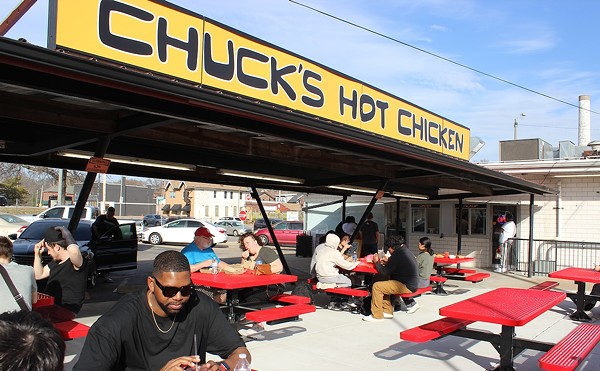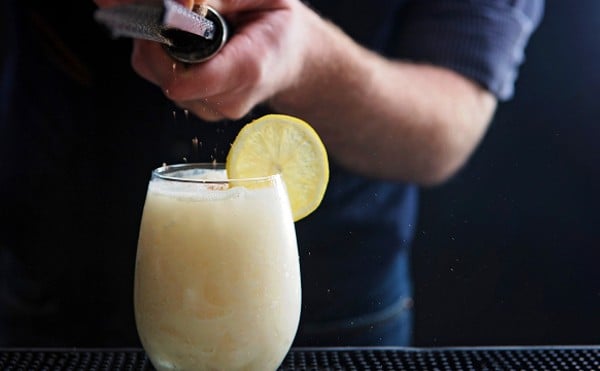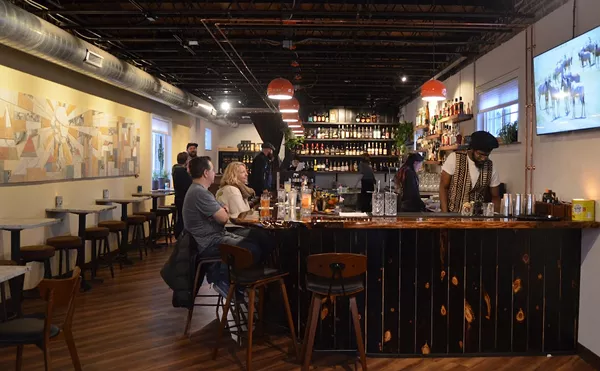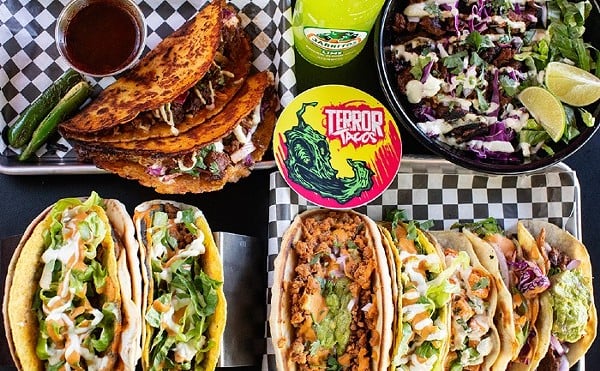For that, I present Graham's Grill and Bayou Bar.
Dan Graham has owned his namesake restaurant and bar for eight years. Don't know how you could've missed it? Old-timers will recall the space as the Kirkwood Loop Lounge, which pleased plenty of palates for 60 uninterrupted years.
Then, as now, I'm sure the spot was a center of conviviality and good cheer. In the front lounge area (not the Bayou Bar; that's next door), there's a revelrous group celebrating someone's birthday, and the din increases exponentially with each new guest's arrival. But that's what a good bar is all about. And in a place that offers Cajun and Creole cooking, let's just say you expect a certain level of merrymaking.
But I was not in a partying mood -- just hungry -- as I straggled in late in search of something other than a burger and beer. After finding a table in a slightly elevated, gazebo-like room in the main dining area, I stared at the menu, soon realizing it would take some lengthy scrutiny. For the indecisive diner, dissecting Graham's menu can feel a bit like when Robin Williams' Russian-defector character in Moscow on the Hudson, overwhelmed by the myriad of choices, loses his composure in a New York grocery store.
At Graham's he would've been taken out on a stretcher, babbling about the eight seafood starters, the six salads, the twenty-one entrées (ranging from steaks and chicken to pasta to barbecue to Cajun/Creole dishes), the numerous "bayou baskets," the several soups and gumbo. With 326 items on the menu, he never would have made it through the fourteen sandwiches, including a massive muffaletta.
As I assessed my dinner options, I started with a small order of the Caribbean smoked-fish dip to assuage my growling belly. The dip is really a mound of cream cheese served on a plate and surrounded by an assortment of Pepperidge Farm crackers. I wasn't expecting much, but then the flavor of the chunky smoked fish made itself present through the mild, creamy cheese; it's an ideal pairing. Lead chef Bob King, speaking like the true frugal Cajun chef he is, explained later that he smokes whatever fish he has left over in the kitchen in his electric smoker. Tonight it was pompano, a mild, white-fleshed fish.
Crab cakes (two for an appetizer portion, four as an entrée) were a pleasant surprise as well. No, they're not 100 percent crab. But they're also not $19 per cake, and they're made fresh. King uses a half-and-half mixture of canned crabmeat and chopped crabstick (or seafood stick, as it's sometimes called). To this he adds chopped scallions and spices, then pats the cakes thin, like pancakes, before they hit the hot skillet. A creamy dressing, spiced lightly, accompanies the dish.
Somewhere along the line, Cajun and Creole became synonymous with "hot" -- much in the same way people think that "blackened" redfish, or "blackened" anything, for that matter, is Cajun (it's not; it's a nouvelle technique developed by chef Paul Prudhomme in the late 1970s, which ushered in the Cajun-restaurant craze of the '80s). Louisiana cooking is well-seasoned and flavorful, but if it burns your mouth, that's because there's too much pepper. King knows this from his years knocking around Soulard-area restaurant kitchens ("I've done many a crawfish boil on street corners in Soulard," he says). If you want it hotter, just ask.
The scallops Creole, for instance, were subtle, relying on the melding of onion, green bell pepper, plum tomatoes and a few spices. Smaller, sweeter bay scallops were simmered in the mixture and served over steamed rice, but the dish suffered from an excess of canned tomatoes and looked as if it had been hastily ladled out, like a bowl of hash at a diner.
Crawfish étouffée -- which some say is the best crawfish meal of them all -- is a simple dish to make. King tanks his up with gobs of tail meat, plus chunks of green pepper, celery and onion -- the holy trinity of Louisiana cooking. Frozen tail meat is currently used and will be until fresh mudbugs are again plentiful, typically between January and June. It's hard to tell the difference between fresh and frozen tail meat when it's blanketed in a roux, so nothing was lost. Unfortunately, I don't think I'll ever have a traditional crawfish étouffée made with the "fat," or what lobster-lovers call the "tomalley" -- the greenish, viscous fluid obtained from the liver and pancreas of a living crustacean -- without going deep into Bayou country.
Graham's does two types of gumbo: seafood and chicken with pork. The former uses whatever fish is on hand, okra and filé powder. The latter, more of a soup really, omits the okra and powder. Both incorporate the holy trinity.
All roux starts the same: some type of fat (such as butter) and flour cooked slowly in a heavy, preferably iron, skillet. Variations come from the length of cooking time. Prudhomme is said to prefer a smoky-flavored, near-coal-black roux for his gumbo. King makes different roux for different dishes. For étouffée and for the pork-and-chicken gumbo, he cooks up a dark-brown roux in an iron skillet so that the dish, he explains, won't look so white. And sometimes he makes the roux with olive oil -- or even bacon grease. (I wish Graham's would advertise that on the menu board: "Tonight's roux is made with bacon grease." I'd show up every time.)
King says he's most proud of his red beans and rice. When asked why, he explains in his typical understated manner: "It's just the meat that's in it, and the beans and all -- it just works out perfect." Indeed, when you mix up a big pot of beans, rice, smoked ham shanks and andouille sausage ("And sometimes we put chicken in there," King adds), you have something quite admirable.
Wines at Graham's are nothing spectacular, but they are cheap and of a better quality than most wines at similar eateries. "Premium" bottles, such as a Hess Select chardonnay or a Castle Rock cabernet sauvignon, will set you back only $18 and $16, respectively. Wines by the glass are $4.50 to $5, with four whites and three reds to choose from. The house wines (Inglenook and Paul Mason) are even less expensive and are available by the glass and carafe. Graham's sister and brother-in-law own the Sugar Creek Winery in Defiance, and five of their wines are offered, two by the glass ($5).
When it comes time for something sweet, know that all desserts except the bread pudding are supplied by outside purveyors. Included on the dessert menu are the expected cheesecake and Key lime pie (the double-chocolate cake was also tempting, because it's hard to find a good, plain chocolate cake). If you have room, the bread pudding is a must: The dessert is composed of chunks of French bread and a delectable sauce made by boiling orange juice concentrate, lemon juice, rum and brown sugar, until the ingredients are transformed into a syrupy, aromatic treasure.
Graham's encourages diners "to experience a bit of Key West in Kirkwood" -- which is a bit confusing, given the New Orleans-centric food. The atmosphere is festive with several large, well-stocked fish tanks, plenty of memorabilia from the Grahams' vacations and a lot of faux gazebos.
Graham's is one of those good neighborhood eateries, a place you want to go when the craving strikes for a cold beer and fried clams, or a cold beer and a burger, or a glass of wine and étouffée. And if the experience doesn't live up to your dormant memories of New Orleans dining? No big deal. You didn't drop a bundle, the food was made to order, and everybody got what they wanted. Now lighten up and go next door to the Bayou Bar for some Foosball.





